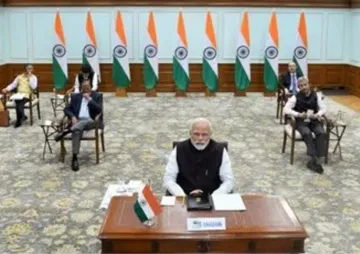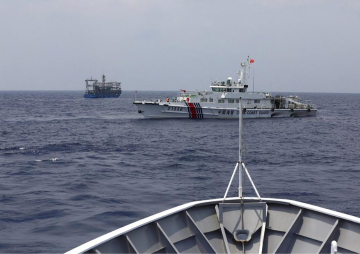Drawing a parallel with the SAARC, Dr. G. Sundaram, former Indian Representative to the EU, said the EU has overcome many issues of the kind of SAARC, and managed them better.

Dr. G Sundaram, IAS (retd), former Commerce Secretary and Indian Representative to the European Union at Brussles, spoke on 'India and the European Union' at the Chennai Chapter of Observer Research Foundation on Saturday, 13 March 2011.
Dr. Sundaram began his presentation with a newspaper quote that India and the EU were strategic partners whose relationship did not carry the same level of publicity or hype when compared to New Delhi's ties with other countries. He pointed out that both India and the EU shared a similarity as common market economies.
Recalling that former British Prime Minister Winston Churchill had envisaged a 'united states' of Europe on the lines of the United States of America, Dr. Sundaram said that the EU today was more than a common market. He said the EU today was a customs union, an economic union with a uniformed monetary policy and a super-national union wherein all laws were binding upon all member-States without exception. It was in this context that Dr. Sundaram mentioned that the EU sent directions, decisions and regulations to its member-States, which became a law.
Recalling the history of the EU, Dr. Sundaram said the European Union has evolved into its present form over the years. Post-Second World War, the political and defence co-operation between some of the European countries met with a limited success, whereas economic co-operation among them was more successful. This was in the form of the European Economic Committee (EEC). The forerunner to the EEC was the European Coal and Steel Committee (ECSC). The ECSC was primarily a platform that was aimed at addressing the coal and steel needs of both Germany and France. The EEC led to the formation of the European Atomic Energy Committee in 1958.
The success of the EEC was that it created trade rather than creating trade-diversion. That is to say that the trade between the members of the EEC increased, and it was not at the expense of the members. Despite its success, the EEC was not free of issues. The most important issue pertained to the membership of the UK, which had withdrawn from the EEC in 1955. Britain's application to re-join the EEC was shot down by France in 1961. Prolonged negotiations finally resulted in Britain becoming a part of the EEC in 1973. It was during this time that the EEC witnessed a turf-war between Germany, Britain and France.
The EEC was predecessor to the EU, and had even initiated an integration programme. In 1986, a single "Europe Act" was passed which resulted in all member-States shared a common flag and national anthem. This also involved the unification of all commissions like the EEC in 1967. The EU as a body came into existence only in 1992, flowing from the success of the EEC. The cornerstone in the evolution of the European Union was the 2009 Lisbon Treaty, which gave member-States a uniformed security and foreign policy. This treaty created the office of the President of the Council of the EC, with a governing council whose members were either the Heads of State or Heads of Government of the member-nations. The executive arm of the EU is the European Commission with the Parliament of the EU in Staatsburg. The Secretariat is in Brussels and Luxemburg houses the EU Court of Justice. This has resulted in the EU becoming a political entity at times, from being an association of States.
The Lisbon Treaty also provided for a common citizenship, a charter on fundamental rights, including right to life. Before the Lisbon Treaty, a common currency in the Euro was created in 2002. This was accompanied by the Schengen Agreement, which has enabled the free movement of people within the Union.
Dr. Sundaram said India established its diplomatic mission in Brussels as early as 1962. Its relationship with the forerunner of the EU has resulted in an economic and trade agreement in 1980. In 1993, India signed a partnership and economic co-operation agreement, which has now become a Free Trade Agreement. This has resulted in an increase in trade from Euro 69 billions to Euro 100 billions. The relationship over the years transformed from a commercial to economic and to a strategic partnership. Despite this, in areas like labour rights, sustainable development and environmental issues, the respective positions taken by the EU and India have remained a stumbling block to further growth of bilateral relations. The European sensitivity on these scores is matched only by the political dynamics in India. At the same time, the EU has acted as a gateway for India, to the whole of Europe on matters of trade, science and technologies.
Dr. Sundaram also touched upon issues pertaining to sovereignty and commercial interests. The EU has dealt with this question by having well defined treaties that take into account the interests of all member-States. This apart, the EU as a body is flexible to accommodate the interests of all its members. To this end, member-States have accepted a few aspects of the EU as a whole and have left other aspects to be dealt with in the future -- thus providing enough room for every member to adjust and to be accommodated within the EU. As an example, he cited Britain, which is a full-fledged member of the EU, but is not a part of the common currency or the Euro zone.
Added to this was that none of the member-States has fully met with the obligations set forth by the EU. The economic policies of member-States are not always in tune with those prescribed by the EU. The EU is influenced by the members and therefore, the interests of individual States have in fact influenced the interests of the organisation. At the same time, the speaker ruled out the possibility of any cartelisation within EU. In this context, there is a great deal of diversity within EU, where Germany is a financial super-power. This has thrown the door open, for a number of issues to be taken up in and by the EU. The most prominent of these issues is that of immigration. This is primary due to the diversity that lies in Europe, which runs parallel to the economic development of individual States. This is also compounded by the variation in the laws of individual countries with respect to immigrants that come from outside the EU. At the same time, the need for foreign skilled labour has also been a driving force.
Another point of discussion within the EU is its expansion. Due to the size and nature of the organisation, new members will enjoy all the benefits of the EU but may not have become an integral part of the EU's governing council. This is so because of the size of the organization with all its member-States. Dr. Sundaram pointed out that the membership of Turkey has been a sore point. He observed that the European Union was predominantly made up of Christian nations where as Turkey is a Muslim- dominated country.
Drawing a parallel with the South Asian Association for Regional Cooperation (SAARC), Dr Sundaram said that the EU has overcome many issues of the kind, and managed them better than the other regional grouping. The European Union has taken the economic route to co-operate and not the political or the military form of co-operation that have lesser chances of success. Here the primary issue for SAARC is the size of India, which ends up making India a big brother of the region. The EU did not have such problems as the SAARC, he said.
(This report was prepared by Sripathi Narayanan, M Phil (Defence and Strategic Studies), University of Madras)
The views expressed above belong to the author(s). ORF research and analyses now available on Telegram! Click here to access our curated content — blogs, longforms and interviews.




 PREV
PREV

